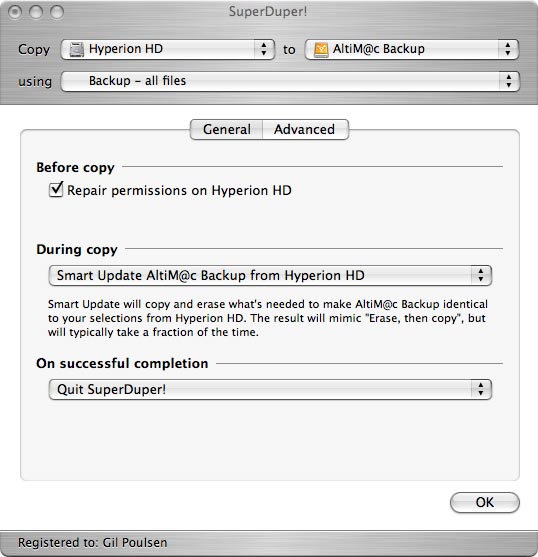

- #Superduper clone recovery partition how to#
- #Superduper clone recovery partition upgrade#
- #Superduper clone recovery partition Pc#
- #Superduper clone recovery partition mac#
- #Superduper clone recovery partition windows#

Click on the folder icon and select the location. Here you can select the device you want to convert to a recovery drive.
#Superduper clone recovery partition windows#
This could be the reason OEM recovery no longer works (although Windows works fine) but I'm not certain. On the destination SSD, all OEM partitions become 'normal' primary partitions (even with sector-by-sector copy and no-resizing). Clone to your heart's content - for free. Once you have opened the application, go to the 'Backup' section, and then click on the 'System Backup' option. I was surprised to know none of the apps clones the OEM recovery partitions correctly. Give SuperDuper a workout on your own system.
#Superduper clone recovery partition Pc#
And it runs beautifully on both Intel and Power PC Macs! Its incredibly clear, friendly interface is understandable, easy to use, and SuperDuper's built-in scheduler makes it trivial to back up automatically. SuperDuper is the wildly acclaimed program that makes recovery painless, because it makes creating a fully bootable backup painless.
#Superduper clone recovery partition mac#
mac $ diskutil listģ: Apple_Boot Recovery HD 650.0 MB disk0s3Ġ: Apple_HFS Macintosh HD *999.0 GB disk1Ģ: Apple_HFS Macintosh SSD 999.2 GB disk4s2ģ: Apple_Boot Recovery HD 784.2 MB disk4s3 I don't know why the two are different nor do I know what will happen when I swap the internal and external drives. Here is the result after I cloned Macintosh HD to Macintosh SSD. It did prompt me when I clone my one partition startup drive. I gather there is a way to clone the recovery partition manually. If it on the source volume, you will get a prompt. There is an option to add this at the end of the clone. (SuperDuper is now compatible with Big Sur & Monterey. CCC is a partition cloner not a volume cloner. Go to step 1 This guide will go through the process of cloning your existing software, OS, and data to a new hard drive.
#Superduper clone recovery partition upgrade#
When you upgrade your existing startup drive, you can at any time boot from your external drive and go back to your existing system.Ĭreated when you initialize/format the drive. You can boot from the external drive to verify that you have a good clone. The data has to fit.Ĭarbon Copy Cloner (CCC) will copy your startup drive to an external firewire drive. The drives do not need to be the same size. You need to format the SSD before the clone.

I used CCC to clone my internal 1T hd to an external SSD. And I guess that the disk5 is the timemachine backup at that moment. To be completed this is the partition scheme which I can't totally interpretate with certainty, as you can see there is a VM partition don't know why it's there nor did I tried to access it. Side question: How can I make a image of a partition of its content and not the whole block size partition ? I read that diskutility is now using a block scheme and not a file-present scheme to backup. To restore from that external hard drive, attach it to your Mac either by USB or FW (whichever you used to make the clone). Should I apply this technique or is the problem somewhere else? Problem is that I can't get the system partition to shrink even if there is only 170G occupied. Or is this now irretrievable? Thank you for any help.I wanted to swap my 1TB old iMac HDD to a 1TB SSD but apparently it's not that easy with diskutil under mojave recovery system.įrom a disk to disk it's impossible since the disc is complaining to not be Apple_HFS so I needed to point to the container partition of the system disk but then the container is complaining that there is not enough space on the destination disk (since it's an ssd I guess that the total size vary a little with an HDD). I just assumed an image could be written block-for-block to recover machine state.Īnyway, I'd be most grateful if any of you could help with this by pointing me in the correct direction. I confess, I don't really understand how APFS works or what a "volume" means in that world. Now, I know I made many mistakes in this process and I won't win any Apple Support Engineer awards but I'm sure there must be some way to recover the information in the image file. I also tried to restore the image back to the erased SSD but was met with the news that I can't restore images containing APFS volumes. But how? It seems obvious that it should be doable with the Migration Assistant, but I can't figure out how. Now, I'd like to recover settings, programs and files from the image backup. I was able to use Internet Recovery to reinstall High Sierra, but only after erasing the internal drive. I used Disk Utility in recovery mode to create a disk image before moving further (ominous music). Sadly, the only Time Machine backup is from several years ago. Unfortunately, every time the Air starts now, it immediately tries to upgrade to Monterey but crashes after 29 minutes. Apparently, there was not enough disk space (disk util said 16GB available, Monterey said less than 11GB available), so the upgrade failed.
#Superduper clone recovery partition how to#
How to use a disk image to migrate after a failed upgrade? Inadvisably, I tried to upgrade from High Sierra to Monterey on a MacBook Air.


 0 kommentar(er)
0 kommentar(er)
